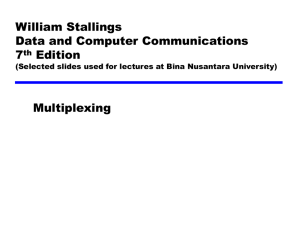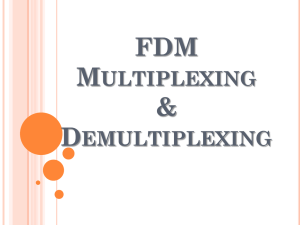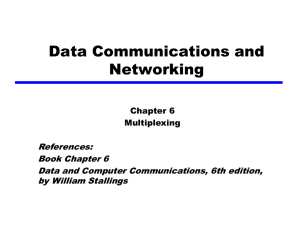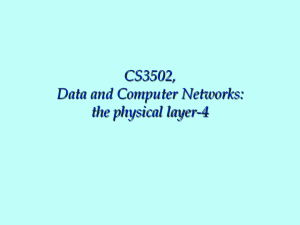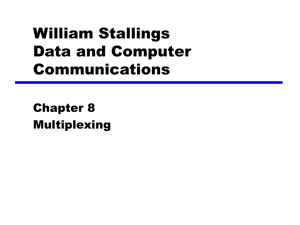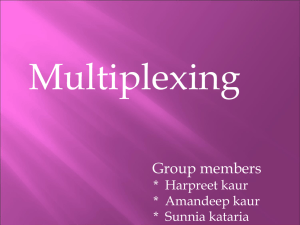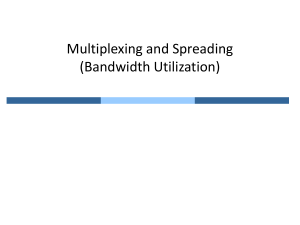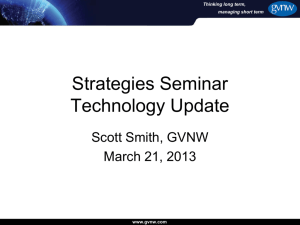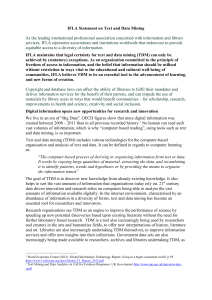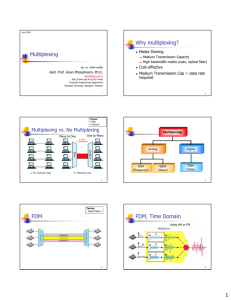Multiplexing
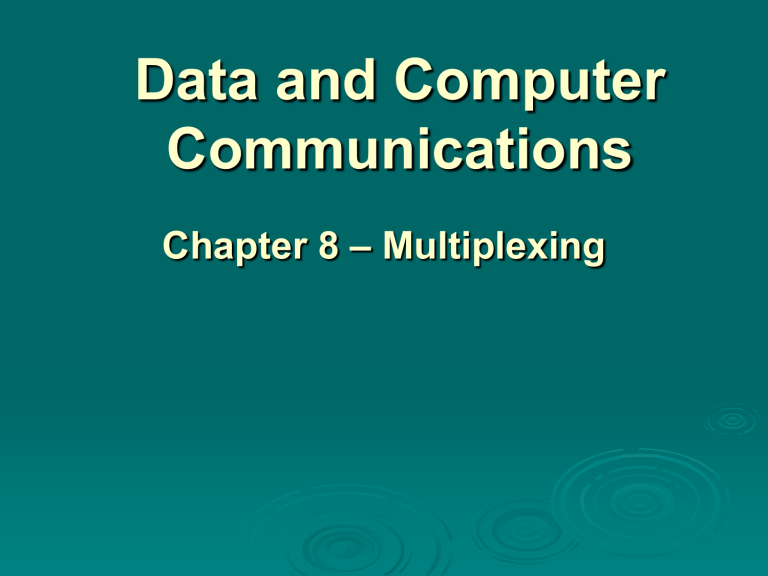
Data and Computer
Communications
Chapter 8 – Multiplexing
Multiplexing
multiple links on 1 physical line
common on long-haul, high capacity, links
have FDM, TDM, STDM alternatives
Frequency Division
Multiplexing
FDM
System
Overview
FDM Voiceband Example
Problem
# Given the following information, find the maximum bandwidth for each signal source.
A) FDM multiplexing
B) Total available BW is 7900 Hz
C) Three signal sources
D) A 200-Hz guard band between each pair of source.
Wavelength Division
Multiplexing
FDM with multiple beams of light at different freq
carried over optical fiber links
commercial systems with 160 channels of 10 Gbps lab demo of 256 channels 39.8 Gbps
architecture similar to other FDM systems
multiplexer consolidates laser sources for transmission over single fiber
Optical amplifiers amplify all wavelengths
Demux separates channels at the destination
also have Dense Wavelength Division
Multiplexing (DWDM)
Synchronous Time Division
Multiplexing
TDM
System
Overview
# Four channels are TD multiplexed. Each channel sends 100 bytes/s and 1byte per channel is multiplexed. Find the size and duration of the frame, as well as the bit rate of the link.
# 2 end offices, 1 node in between with 1-
MHz trunks, average phone makes four long distance calls / 8-hour workday, each call of 6-minutes duration, long distance calls are 10% of the total.
Find the maximum number of phones at each end office. (50000)
TDM Link Control
no headers and trailers
data link control protocols not needed
flow control
data rate of multiplexed line is fixed if one channel receiver can not receive data, the others must carry on corresponding source must be quenched leaving empty slots
error control
errors detected & handled on individual channel
Data Link Control on TDM
Framing
no flag or SYNC chars bracketing TDM frames
must still provide synchronizing mechanism between source and destination clocks
Added-digit framing
one control bit added to each TDM frame
identifiable bit pattern used as control channel e.g. alternating 01010101…unlikely on a data channel compare incoming bit patterns on each channel with known sync pattern
Pulse Stuffing
Pulse Stuffing
stuff extra dummy bits or pulses into each incoming signal until it matches local clock have outgoing data rate (excluding framing bits) higher than sum of incoming rates stuffed pulses inserted at fixed locations in frame and removed at de-multiplexer
TDM Example
# Four analog signals are to be TDM over a channel. Each baseband analog signal is band-limited to 500 Hz. Find the total bit rate of the channel considering 4-bit PCM samples.
# A TDM system accommodates four 300bps digital inputs and one analog input of
500-Hz BW (encoded into 4-bit PCM). If
20 frames are sent per second, find the size of the frame and the analog and digital bits per frame.
Statistical TDM
in Synch TDM many slots are wasted
Statistical TDM allocates time slots dynamically based on demand
multiplexer scans input lines and collects data until frame is full
output data rate is lower than aggregate input line rates
may have problems during peak periods
must buffer inputs
Statistical TDM Frame Format
Frame Optimization
- Relative addressing
Omit address, use ‘bit-map’ register
- Length field: encode length
2
2
7
2
9
3
Input
6
Output Capacity = 5000 bps
Output
5
5
5
5
5
4
2
0
0
5
2
Backlog
1
5
3
Output Capacity = 7000 bps
Output
6
7
2
7
5
2
2
0
0
0
0
Backlog
0
2
0
Summary
looked at multiplexing multiple channels on a single link
FDM
TDM
Statistical TDM
